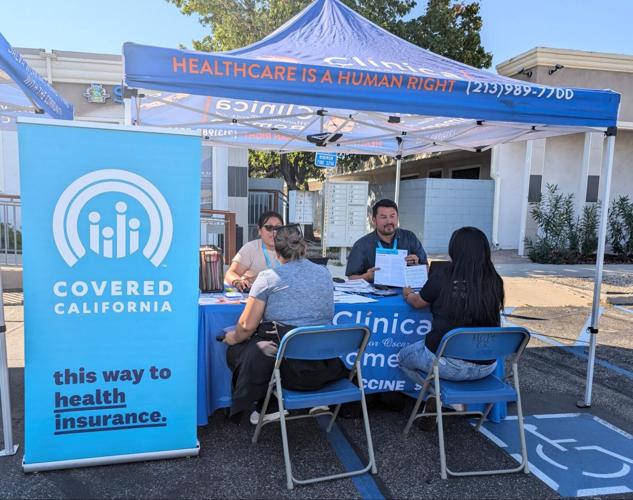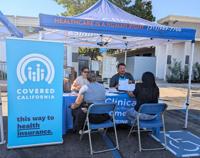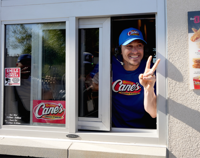
Based in Los Angeles, Clinica Romero’s enrollment team helps residents sign up for health insurance at a community event. Photo courtesy of Clinica Romero.
After a series of health care reforms, California advocates and agencies are now pushing to enroll as many people as possible into the newly-expanded options that will cover more immigrants.
The push comes as the state’s deadline to enroll in a Covered California health plan nears on January 31. And though Latinos are insured in record numbers, a gap still remains – especially for Central Americans.
“The more people know, the more they can take advantage of these programs,” said Martín Pineda, communications manager for Central American Resource Center (CARECEN) in Los Angeles.
In California, about 5% of whites are uninsured compared to 11% of Latinos, according to 2023 American Community Survey (ACS) data.
And though they make up about 660,000 people in the state, about 18% of Guatemalans and Hondurans are uninsured, as are 12% of Salvadorans and 10% of Mexicans.
Latinos make up to 60% of all those eligible for the state’s Covered California insurance options but remain uninsured, according to Covered California officials, despite making up 39% of the state population.
While gaps remain, “that doesn't mean we haven't made a lot of progress with Latino Californians,” says Jessica Altman, Covered California’s executive director
Latinos overall are seeing their lowest uninsured rates ever. Latinos boosted their enrollment through Covered California’s menu of health plans by 31% last year – a bigger bump than any group.
Salvadorans have also boosted their enrollment by 60% and Guatemalans by 70% since 2020, according to Covered California officials.
“We really have made huge investments in making sure that we're doing tailored outreach… Latinos are a very diverse group of people and a one-size-fits-all for Latino outreach is not what needs to happen. So we're trying to be super effective,” says Altman.

As part of their H.O.P.E. program for the unhoused, Clinica Romero connects residents at Boyle Heights’ Tiny Home Village to services. Photo courtesy of Clinica Romero.
Access and affordability has expanded. Medi-Cal, California’s free health care plan, now covers low-income people regardless of immigration status or age. Dreamers under Obama’s DACA program will now benefit from government funds called subsidies to help them pay for various insurance options through Covered California that might otherwise be too costly to afford. Many more at other income brackets also benefit from financial assistance.
Advocates are spreading the word. Situated near MacArthur Park, CARECEN provides job links, education, legal services and heath enrollment fairs for the neighborhood’s jornaleros (day laborers). Across the way is one of Clinica Romero’s health centers, offering underserved residents an array of medical, dental, psychological care and more.
The clinic was founded by Salvadoran refugees in 1983 with a mission inspired by El Salvador’s late social justice icon and archbishop Oscar A. Romero.
“Following his guidance, our mission is simple – we are here to serve the poor and advocate for immigrant rights,” says clinic CEO Carlos Vaquerano.
The clinics’ promotores “go out every day to inform our community to enroll” more people, “whether they are on the street or at the market” so more care can arrive to its largely immigrant clientele – a population marred by many health issues.“A lot of our Latino immigrants come to the clinic when they are very sick, unfortunately,” says Varquerano.
They’re sick from diabetes, displacement and from the traumas of violence experienced in their home countries. Vaquerano himself experienced wartime trauma in El Salvador.
He describes the waves of immigrant trauma: Central Americans fleeing war in the ‘80s and ‘90s. Gang violence driving unaccompanied minors from the region in more recent years. There are also Mexican ex-military soldiers fleeing corruption and cartels.
On the list, Vaquerano includes families separated by deportation under both parties.
“That's a lot of trauma. We have a lot of immigrants that are experiencing that,” Vaquerano says.
He also notes seeing more working but homeless migrants around the neighborhood.
“These are Latinos who wake up very early in the morning, go to work and come back because they don’t have a place to live,” he adds.
Advocates hope that access to mental health care will assuage the longstanding traumas and their associated alcoholism, substance abuse and domestic violence.
As for why enrollment gaps remain, Pineda of CARECEN points to barriers in accessing technology, forms, language and working jobs without benefits in construction or restaurants.
“It's a lot of navigating a new country, a new city. So [health care] is what they get to after a while trying to figure everything out,” Pineda says.
Pineda says families making above Medi-Cal’s income limit might find it hard to afford remaining options, but Altman of Covered California says renewed support from the Biden administration and Gov. Newsom has amped affordability, including providing “Silver” care plans without deductibles for 2025.
The push for enrollment has agencies and organizations working together.
Altman describes a culturally tailored approach in marketing, radio advertising, social media and campaigns run alongside community leaders.
In mid-December, her team was in Mendota in the Central Valley to boost sign-ups and provide health screenings to farmers, joined by Fresno’s Consulate General for El Salvador, Wilbur Alemán.
“That's the type of level of focus that we're doing across our communities,” she says.
Covered California has 14,000 enrollment partners across the state offering diverse language population-focused grants.
This enrollment season, it also gave partners additional funds to have more promotores find and connect people needing coverage.
“We in California believe that healthcare is a right and not a privilege,” Altman says.
“In California, the people that need health care are in the majority of cases – 60% of the people we're trying to reach – Latino. We know that our Latino communities, like all of our communities, deserve health care, want health care and need health care and we're going to make it our mission to help them do that.”













(0) comments
Welcome to the discussion.
Log In
Keep it Clean. Please avoid obscene, vulgar, lewd, racist or sexually-oriented language.
PLEASE TURN OFF YOUR CAPS LOCK.
Don't Threaten. Threats of harming another person will not be tolerated.
Be Truthful. Don't knowingly lie about anyone or anything.
Be Nice. No racism, sexism or any sort of -ism that is degrading to another person.
Be Proactive. Use the 'Report' link on each comment to let us know of abusive posts.
Share with Us. We'd love to hear eyewitness accounts, the history behind an article.